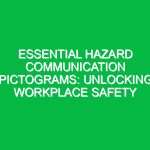Understanding Hazard Communication Standard Pictograms
In today’s complex work environments, effective communication about hazards is crucial for ensuring safety and health. The Hazard Communication Standard (HCS), established by the Occupational Safety and Health Administration (OSHA), mandates that employers must inform their employees about the hazards associated with chemicals they might encounter in the workplace. A key component of this communication is the use of hazard communication standard pictograms, which serve as visual cues to convey the nature of hazards present in various substances and situations.
Pictograms are essential in the Health, Safety, and Environment (HSE) domain because they transcend language barriers, making it easier for a diverse workforce to understand potential dangers. Whether in a manufacturing facility, a laboratory, or a construction site, these symbols provide immediate recognition and understanding, reducing the risk of accidents and injuries.
The Importance of Pictograms in Hazard Communication
Pictograms play a pivotal role in hazard communication for several reasons:
- Immediate Recognition: Pictograms allow for quick identification of hazards, enabling workers to take appropriate precautions without requiring extensive training.
- Universal Understanding: Visual symbols can be understood by individuals who may not speak the same language, making them vital in diverse workplaces.
- Enhanced Safety Awareness: Regular exposure to hazard symbols increases overall safety awareness among employees, fostering a culture of safety and vigilance.
For instance, consider a chemical manufacturing plant where employees handle various substances daily. The presence of pictograms on chemical containers alerts workers to specific hazards, such as flammability or toxicity, prompting them to utilize personal protective equipment (PPE) or adhere to safety protocols.
Key Pictograms in the Hazard Communication Standard
The OSHA Hazard Communication Standard incorporates a set of standardized pictograms to represent different types of hazards. Understanding these pictograms is vital for ensuring safety in the workplace. Below are the key pictograms and their meanings:
1. Flame
This pictogram indicates flammable materials or substances that can ignite easily. It is crucial in environments where fires can occur, such as chemical plants or kitchens.
2. Exclamation Mark
Representing general hazards, the exclamation mark signifies materials that may cause irritation, sensitization, or other health effects. This symbol is essential in workplaces dealing with chemicals that can pose minor risks.
3. Skull and Crossbones
This symbol denotes acute toxicity, indicating substances that can cause severe health effects or death. Its presence on a chemical container serves as a stark reminder to handle the substance with extreme caution.
4. Corrosion
Indicating corrosive materials, this pictogram warns about substances that can cause severe skin burns or eye damage. It is particularly relevant in industries that handle strong acids or alkalis.
5. Health Hazard
This pictogram signifies serious health effects, including carcinogenicity, respiratory issues, or reproductive toxicity. It is crucial for warning employees about long-term health risks associated with certain chemicals.
6. Environmental Hazard
Representing hazards to the environment, this pictogram warns about substances that may cause damage to aquatic life or ecosystems. It is increasingly relevant as environmental regulations become more stringent.
7. Gas Cylinder
This pictogram indicates gases under pressure, which can explode or cause injury if not handled properly. It’s essential in workplaces that utilize compressed gases for various applications.
8. Flame Over Circle
Indicating oxidizers, this pictogram warns of substances that can enhance the combustion of other materials, posing fire risks. It’s vital in chemical storage and handling areas.
Regulations Surrounding Hazard Communication Standard Pictograms
The OSHA Hazard Communication Standard is grounded in the Globally Harmonized System of Classification and Labeling of Chemicals (GHS). This system provides a coherent approach to classifying chemicals and communicating hazard information, including the use of pictograms. The GHS aims to ensure that information about chemical hazards is universally understood, thereby enhancing workplace safety.
Employers are required to:
- Label hazardous chemicals with the appropriate pictograms.
- Provide safety data sheets (SDS) that include detailed information about the hazards associated with chemicals.
- Train employees on how to recognize and respond to the hazards indicated by pictograms.
Compliance with these regulations not only promotes safety but also protects employers from potential legal liabilities related to workplace accidents.
Best Practices for Implementing Hazard Communication Standard Pictograms
To successfully implement hazard communication standard pictograms in the workplace, employers should consider the following best practices:
1. Regular Training and Education
Conduct ongoing training sessions to educate employees about the meanings of various pictograms and their associated hazards. This training should be part of the onboarding process for new hires and occur periodically for existing employees to refresh their knowledge.
2. Clear and Visible Labeling
Ensure that all hazardous materials are clearly labeled with the appropriate pictograms. Labels should be easily visible and legible, even in low-light conditions.
3. Integrate Pictograms into Safety Protocols
Pictograms should be integrated into all safety protocols and emergency response plans. For example, if a fire breaks out, employees should immediately identify the nearest exits and fire extinguishers marked with pictograms.
4. Promote a Culture of Safety
Encourage employees to speak up about safety concerns and report any missing or damaged labels. A proactive approach to safety fosters a workplace environment where everyone feels responsible for maintaining a safe work environment.
5. Use Visual Aids
In addition to labeling, consider using posters or visual aids that display the meanings of various pictograms. Placing these aids in common areas can serve as constant reminders for employees.
Real-Life Application: Case Study in a Manufacturing Facility
Let’s take a look at a hypothetical yet realistic case study in a manufacturing facility that implemented hazard communication standard pictograms effectively.
At XYZ Manufacturing, the management recognized a higher-than-average incident rate related to chemical exposure. After conducting an audit, they found that many employees were unaware of the specific hazards associated with the substances they handled.
To address this, the company initiated a comprehensive training program highlighting the importance of hazard communication standard pictograms. They replaced outdated labels with new, compliant ones featuring the appropriate pictograms. Additionally, they placed large posters throughout the facility explaining each pictogram’s meaning.
Within six months, the facility reported a 40% decrease in chemical-related incidents. Employees felt more empowered to identify hazards, take proper precautions, and utilize PPE effectively. This case exemplifies how effective communication through pictograms can lead to tangible safety improvements.
Conclusion: The Path to Safety Success
In conclusion, hazard communication standard pictograms are indispensable tools in promoting safety in the workplace. They offer immediate recognition of hazards, facilitate understanding across diverse workforces, and adhere to regulatory requirements. By investing in training, clear labeling, and fostering a culture of safety, organizations can significantly enhance their safety protocols.
As we move forward, it is crucial for employers and employees alike to remain vigilant about hazard communication. Recognizing and understanding these pictograms is not just a regulatory obligation; it’s a commitment to safeguarding health, safety, and the environment. By prioritizing this aspect of safety culture, we can pave the way for a safer, more informed workplace.


